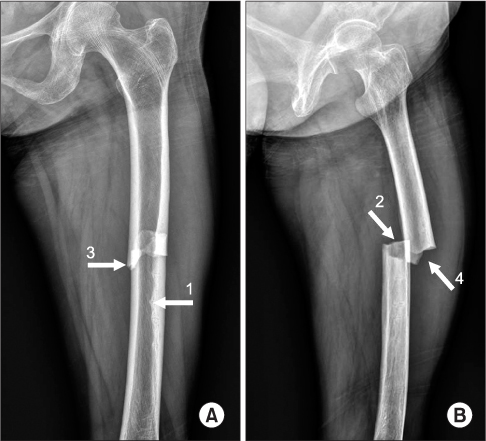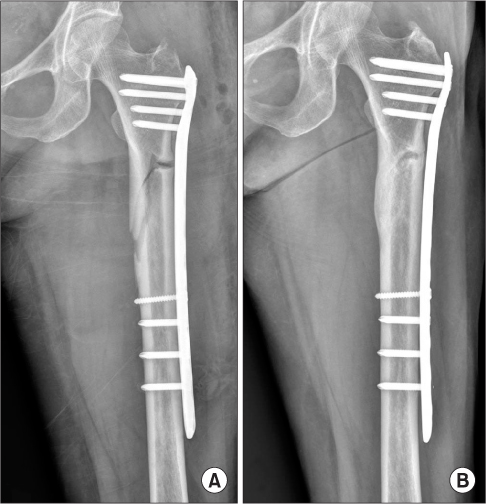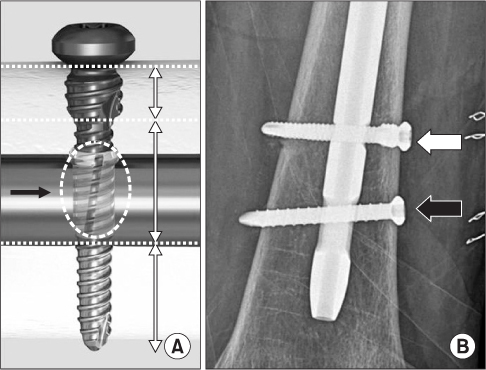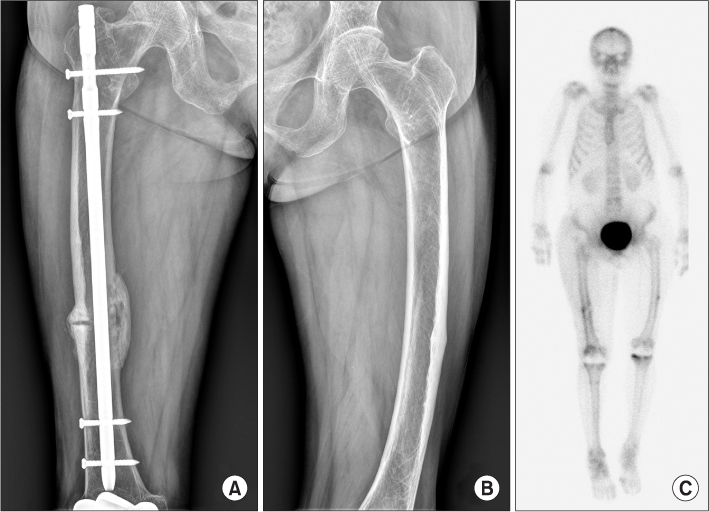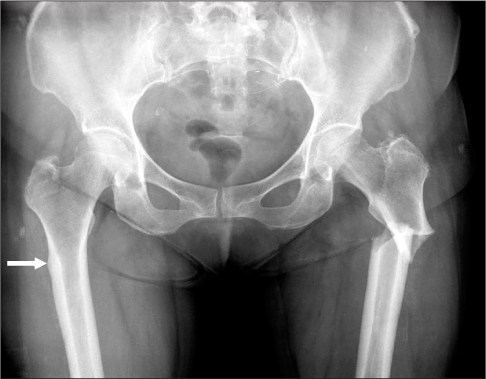J Korean Orthop Assoc.
2013 Jun;48(3):185-189. 10.4055/jkoa.2013.48.3.185.
Surgical Treatment of Atypical Femoral Fracture
- Affiliations
-
- 1Department of Orthopaedic Surgery, Keimyung University School of Medicine, Daegu, Korea. min@dsmc.or.kr
- 2Department of Orthopaedic Surgery, Chung-Ang University School of Medicine, Seoul, Korea.
- 3Department of Orthopaedic Surgery, Seoul National University Bundang Hospital, Seongnam, Korea.
- KMID: 2106671
- DOI: http://doi.org/10.4055/jkoa.2013.48.3.185
Abstract
- Bisphosphonates have been used as first-line therapy to reduce the incidence of osteoporotic fractures. Several publications have recently described the occurrence of low-energy subtrochanteric and femoral shaft fractures with long-term bisphosphonate use, so called atypical femoral fracture. Atypical fracture is a rare condition, and the treatment and its effectiveness have not been adequately reported. Thus, finding appropriate treatment is difficult. In this report, the authors reviewed the treatment of atypical fracture and described helpful suggestions for surgery.
Keyword
Figure
Reference
-
1. Odvina CV, Zerwekh JE, Rao DS, Maalouf N, Gottschalk FA, Pak CY. Severely suppressed bone turnover: a potential complication of alendronate therapy. J Clin Endocrinol Metab. 2005; 90:1294–1301.
Article2. Lenart BA, Lorich DG, Lane JM. Atypical fractures of the femoral diaphysis in postmenopausal women taking alendronate. N Engl J Med. 2008; 358:1304–1306.
Article3. Kwek EB, Goh SK, Koh JS, Png MA, Howe TS. An emerging pattern of subtrochanteric stress fractures: a long-term complication of alendronate therapy? Injury. 2008; 39:224–231.
Article4. Neviaser AS, Lane JM, Lenart BA, Edobor-Osula F, Lorich DG. Low-energy femoral shaft fractures associated with alendronate use. J Orthop Trauma. 2008; 22:346–350.
Article5. Roub LW, Gumerman LW, Hanley EN Jr, Clark MW, Goodman M, Herbert DL. Bone stress: a radionuclide imaging perspective. Radiology. 1979; 132:431–438.
Article6. Clamp JA, King RJ, O'Hara JT, Hahn DM. Osteoporotic pelvic insufficiency fracture with gross instability. J Trauma. 2008; 64:1380–1382.
Article7. Koh HS, Kang YK, Lee HY, et al. Insufficiency fractures of the femoral shaft associated with osteoporosis. J Korean Fract Soc. 2004; 17:19–24.
Article8. Goh SK, Yang KY, Koh JS, et al. Subtrochanteric insufficiency fractures in patients on alendronate therapy: a caution. J Bone Joint Surg Br. 2007; 89:349–353.9. Cao Y, Mori S, Mashiba T, et al. Raloxifene, estrogen, and alendronate affect the processes of fracture repair differently in ovariectomized rats. J Bone Miner Res. 2002; 17:2237–2246.
Article10. Das De S, Setiobudi T, Shen L, Das De S. A rational approach to management of alendronate-related subtrochanteric fractures. J Bone Joint Surg Br. 2010; 92:679–686.
Article11. Weil YA, Rivkin G, Safran O, Liebergall M, Foldes AJ. The outcome of surgically treated femur fractures associated with long-term bisphosphonate use. J Trauma. 2011; 71:186–190.
Article12. Prasarn ML, Ahn J, Helfet DL, Lane JM, Lorich DG. Bisphosphonate-associated femur fractures have high complication rates with operative fixation. Clin Orthop Relat Res. 2012; 470:2295–2301.
Article13. Shane E, Burr D, Ebeling PR, et al. American Society for Bone and Mineral Research. Atypical subtrochanteric and diaphyseal femoral fractures: report of a task force of the American Society for Bone and Mineral Research. J Bone Miner Res. 2010; 25:2267–2294.
Article14. Demiralp B, Ilgan S, Ozgur Karacalioglu A, Cicek EI, Yildrim D, Erler K. Bilateral femoral insuffiency fractures treated with inflatable intramedullary nails: a case report. Arch Orthop Trauma Surg. 2007; 127:597–601.
Article15. Ha YC, Cho MR, Park KH, Kim SY, Koo KH. Is surgery necessary for femoral insufficiency fractures after long-term bisphosphonate therapy? Clin Orthop Relat Res. 2010; 468:3393–3398.
Article
- Full Text Links
- Actions
-
Cited
- CITED
-
- Close
- Share
- Similar articles
-
- Surgical Treatment of the Atypical Femoral Fracture: Overcoming Femoral Bowing
- Surgical Outcomes of Atypical Femoral Fracture
- Epidemiology and Clinical Features of Atypical Femoral Fractures
- Insufficiency Fracture of the Femoral Neck after Intramedullary Nailing for the Treatment of Atypical Femoral Fracture - A Case Report -
- Atypical Femoral Fracture Occurring at a Proximal Screw Insertion Site after Plate Removal in a Distal Femoral Fracture

